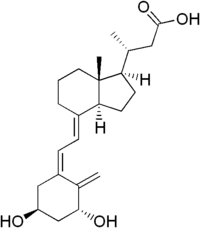Calcitroic acid
Calcitroic acid (1α-hydroxy-23-carboxy-24,25,26,27-tetranorvitamin D3) is a major metabolite of 1α,25-dihydroxyvitamin D3 (calcitriol).[1] Often synthesized in the liver and kidneys, calcitroic acid is generated in the body after vitamin D is first converted into calcitriol, an intermediate in the fortification of bone through the formation and regulation of calcium in the body.[2] These pathways managed by calcitriol[2] are thought to be inactivated[3] through its hydroxylation by the enzyme CYP24A1, also called calcitriol 24-hydroxylase.[4] Specifically, it is thought to be the major route to inactivate vitamin D metabolites.[3]
 | |
| Names | |
|---|---|
| IUPAC name
(3R)-3-[(1R,3aR,4E,7aR)- 4-[(2Z)-2-[(3R,5R)-3,5- Dihydroxy-2-methylene-cyclohexylidene]ethylidene] -7a-methyl-2,3,3a,5,6,7-hexahydro-1H -inden-1-yl]butanoic acid | |
| Identifiers | |
3D model (JSmol) |
|
| ChemSpider | |
PubChem CID |
|
| UNII | |
CompTox Dashboard (EPA) |
|
| |
| |
| Properties | |
| C23H34O4 | |
| Molar mass | 374.514 |
Except where otherwise noted, data are given for materials in their standard state (at 25 °C [77 °F], 100 kPa). | |
| Infobox references | |
Hydroxylation and further metabolism of calcitriol in the liver and the kidneys yields calcitroic acid[2], a water soluble compound that is excreted in bile.[2]
A recent review suggested that current knowledge of calcitroic acid is limited, and more studies are needed to identify its physiological role.[1]
In case where a higher concentration of this acid is used in vitro, studies determined that calcitroic acid binds to vitamin D receptor (VDR) and induces gene transcription.[1]
In vivo, studies determined that calcitroic acid, along with citrulline, may be used to quantify the amount of ionizing radiation an individual has been exposed to.[5]
References
- Yu OB, Arnold LA (October 2016). "Calcitroic Acid-A Review". ACS Chemical Biology. 11 (10): 2665–2672. doi:10.1021/acschembio.6b00569. PMC 5074857. PMID 27574921.
- Meyer, Daniel; Rentsch, Lara; Marti, Roger (2014). "Efficient and scalable total synthesis of calcitroic acid and its 13C-labeled derivative". RSC Adv. 4 (61): 32327–32334. doi:10.1039/c4ra04322g. ISSN 2046-2069.
- Jones G, Prosser DE, Kaufmann M (January 2014). "Cytochrome P450-mediated metabolism of vitamin D". Journal of Lipid Research. 55 (1): 13–31. doi:10.1194/jlr.R031534. PMC 3927478. PMID 23564710.
- Sakaki T, Kagawa N, Yamamoto K, Inouye K (January 2005). "Metabolism of vitamin D3 by cytochromes P450". Frontiers in Bioscience. 10: 119–34. doi:10.2741/1514. PMID 15574355.
- Goudarzi, Maryam; Chauthe, Siddheshwar; Strawn, Steven J.; Weber, Waylon M.; Brenner, David J.; Fornace, Albert J. (2016-05-20). "Quantitative Metabolomic Analysis of Urinary Citrulline and Calcitroic Acid in Mice after Exposure to Various Types of Ionizing Radiation". International Journal of Molecular Sciences. 17 (5): 782. doi:10.3390/ijms17050782. ISSN 1422-0067. PMC 4881599. PMID 27213362.